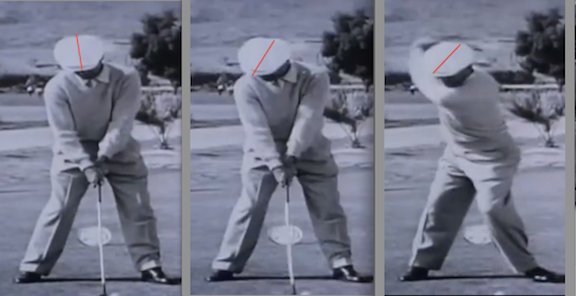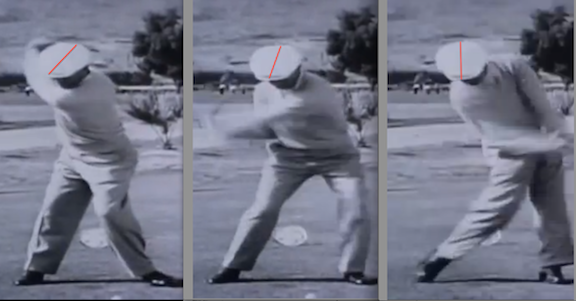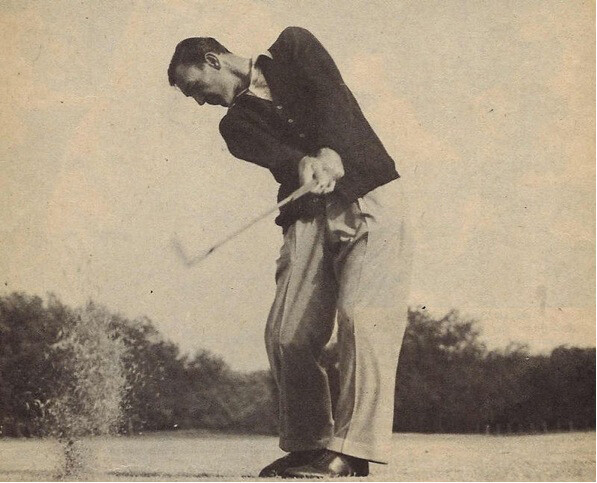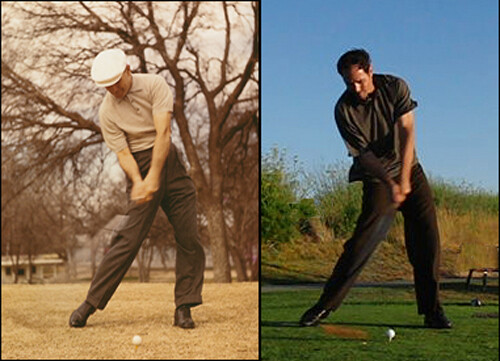note cup of left elbow

Hogan head movement.
Interesting in relation to spine tilt.


I’ve re-read and re-read that passage from 5 Lessons and when he talks about the hips turning fast, can’t go too fast, his focus is actually about creating maximum tension to cause greater speed, not directly spinning the hips early to cause greater speed. He explicitly says create as much tension as possible, the more tension the better. Several other sources including Power Golf he talks about applying speed as a gradual process and the transition being ‘unhurried’. So he actually means: create more tension on the backswing, more tension = naturally more speed potential to be released. Not ‘spin the hips as violently as possible’. Weight doesn’t flow naturally onto the resilient left leg, as he writes, if you jerk and snap that hip about. Not to mention will play havoc for the ability to manage the club shaft and clubhead.
Athleticism is about managing the elasticity of energy in the body, and one way to wreck that is to violently and jerkily thrash your pivot around. Clear to me his hip work was very late, not very early. His early hip work was accurate, rather than forceful, he just had a higher ceiling of power potential from his pelvis due to how he pivoted back.
I would agree with everything you said there. The last few years while this site was down I have been deconstructing Hogan’s action from the inside out… strictly from a standpoint of dynamics and applied pressures of pivot rotation and protocols for how Hogan uniquely transitioned the club into the downswing. It’s absolutely brilliant engineering, and as far I am concerned, I have not seen any instructor even close to understanding what he was actually doing. I don’t believe you can get there from the armchair. You have to get inside that kind of swing to really understand the techniques he applied. I am 100% confident I can teach it now. However, it’s a VERY athletic move, make no mistake… this is not for the faint of heart or the lazy! I’ll be putting a course together soon for those interested in exploring such an undertaking.
I have had the advantage of receiving some of that instruction on the Deck. Athletic is an understatement!
I would be interested in that.
I chose my profile picture because it is ‘just after transition’ and appears to me to show the fantastic stretch and coil still present, the torque through his spikes up his body almost in a clockwise helical fashion, the right arm loaded back, and the clubshaft loaded down his back and poised with weight.
That picture and a few others (the bunker shot taken from ahead with the blue cardigan and body open; the wood shot from the same course and what I call the ‘shaft stress’ picture where he is in all grey with PP3 almost white knuckled) I find are fantastic visuals for me when I practice. My profile picture I try and feel the clockwise pressure through the feet as I move into the downswing, the pivot lag of the pivot train, and I agree it is not ‘easy’. I don’t know if I am an athlete but it feels like a stressful athletic motion is required to be practiced. I looked up metal spikes the other day but can’t see where I could get some. Or be permitted them.
Same with the opening of the body pictures, I feel it in soreness in my left leg IT band when I know I replicate it, whereas I used to feel stress on my knee from spinning out, which is a ‘cheaters’ way to fake the look of the body rotation minus the dynamics. I’ve periodically felt the energy that is created from pivoting with the arms packed in. It is always a ‘wow, so that’s what he must have felt’ (or felt similar) moment.
My personal issue is I hit released pull hooks, and held off push slices. So I figure my path is neutral, I just don’t have control of the clubface. Or my acceleration profile, tipping the shaft out too early. No coincidence I play my best golf when I lay the shaft off and under coming down, and then tip it out on plane, into impact. I’ve always felt you need to work in a flow that is either moving up or down, under or over the plane, using pressures that are more discernible (and therefore more easy to replicate the feel of) but to stay on plane exactly to me is difficult.
Or having the mental control to ‘let go’. And, I’d rather do something ‘active’ under pressure, than ‘let it go’ under pressure. I can’t see that I can possibly cultivate that ‘3 off the tee’ feeling, that produces a long straight shot, because you mentally can’t lie to yourself about the different consequences on your score. Inherently you know the value of a first tee shot. So searching for a mental attitude to employ as well as physical improvement.
My best shots, drives really, I feel like I’m piping it down the centre, it’s not ever going left or right. I can cut it round all day, and 100% eliminate left, but that’s hitting a hold off cut shot. Sometimes it over cuts and I’m giving up to 30 yards on bad shots, they’re in play but it’s not viable long term.
So I used to visit ABS site about a decade ago and am pleased to see it again and in this format.
Cheers John
Great to have the site back up and running as you said. A very frustrating thing to see it falling off the cliff of technology. The old site was written in coding language that became obsolete. One of our students here William Hanisch figure out how to do the migration to this new platform. We all owe him a huge THANK YOU!
That being said, you make a lot of good points in your post. Do something active under pressure…eliminate the left side. Glad you have felt the “wow” factor from a tight rotation of the pivot and packed in arms. Playing your best golf with the laid off shaft feeling through transition tells me you are on the right path!

This really sums up what I like to feel post impact. Clubface square to the shoulder rotation… not rolled over. Still maintaining nice flexation in the left knee that is being pulled straight later by the torso rotation. Although you can’t see it easily, the right elbow is still bent, taking that problematic moving part out of the golf swing. For the Module 9 students, this is textbook shot shaping protocol.
That is the fairway bunker shot I meant with the blue cardigan, absolutely ripping it. To think what he could have done in his prime. And this one below I have as visuals on my phone for post impact pivot thrust. Visualising myself moving through this attitude is something I have more as a ‘swing thought’ compared to years ago, and I’m trying to cultivate the feel to accompany it. In the one below you can see the shaft stress, the PP3 stress, the grimace on his face, the other thing I notice is his left wrist has gone from flexion to flat whilst still with an extended right wrist. Proof he rotated the club round the wrist without it breaking down. He didn’t artificially shove the hand forward, the rotational attitude meant he couldn’t have left wrist flipping attitude. All the work was PA3 travel, not even 1mm of left wrist flip. It’s not strength IMO that stops flipping, it’s moving the clubhead in an attitude that precludes flipping (rotating forearms).

These below are from a video and don’t show the ferocity of his core opening from closed off, laid off; to opened up, upper arms welded tight and forearms giving it plenty. I’ve always felt he basically put himself in a position to not be able to physically hook it - equipment, clubface, etc and then tried to hook the almighty out of it: maximum body, maximum hands. Easier to work with maximums.
TGM has ‘learn feel from mechanics’. I think it is more, ‘learn dynamics from feel’. If you are half off yes, difficult to tune in. Think you said a rollercoaster without rails. But if you are dealing with maximums, you check your stance, check your grip, your waggle, and you have it that day.
Great post!
Thanks for your thoughts and insights!
“I recommend you practice a training exercise that’s designed to school a golfer to entrust his swing not to his hands but to his arms and body. Start in the position of address with the upper part of your arms and your elbows glued to the sides of your chest. Exaggerate this adhesion, if anything. With your arms held as stiff as the pendulum of a clock, have the turning of the body swing the arms back about halfway to the top of the backswing, then swing them forward about halfway to the finish of the follow-through . . . back and forth, back and forth, breaking your left knee and right elbow on your half-swing back, breaking your right knee on your half-swing forward and, later, the left elbow. As you continue to do this, you will get the feeling that you are swinging with the hips, that the body is swinging the club. The effect of this exercise is to exaggerate a fundamental fact and feeling you want to have about the full golf swing: the action of the arms is motivated by the movements of the body, ”-BEN HOGAN.
Love this picture! Both Hogan and John really look like everything that has happened prior to that moment was done with the intent of accelerating viciously beyond impact. Rotation stored, ground resistance locked and loaded, forearms have ample range of motion, nothing has been “spent”….beautiful!

What was with that extra spike!!!???!!!
We know it can’t be Moe, or maybe it can. Moe, that you?
No, just some scrub i saw on the range…said he could accelerate past impact. I was like, OK ![]() !
!
I filmed him for you guys…
I think that extra spike was to put out his cigarettes…couldnt risk losing traction.
Is that from a full swing do you know, NRG?




